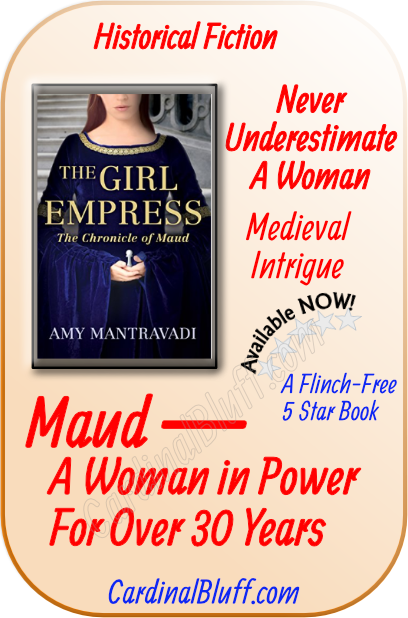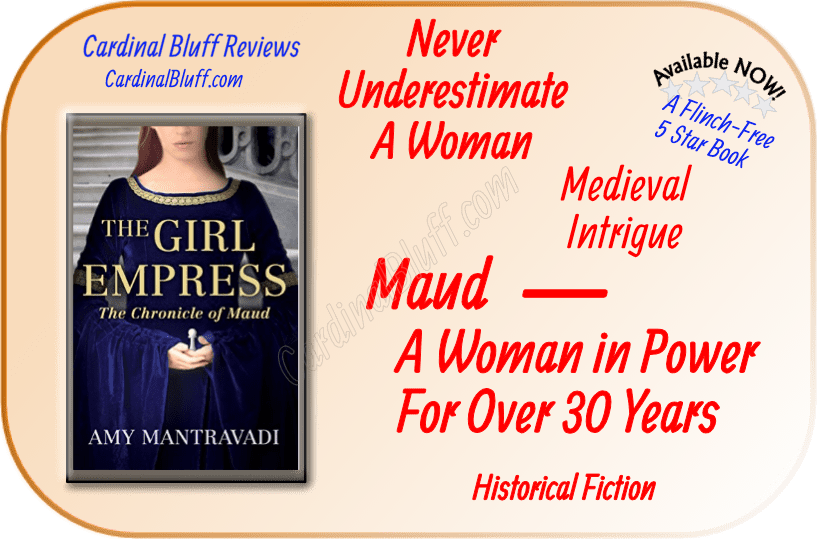Amazing detail from 10th Century fills this story, letting us peek into the life and times of a devout child who would be a Girl Empress and a Queen of multiple countries. Mathilda (Maud) learned that she would be legally married to Henry V, Holy Roman Emperor at age 8. From age 11 years, she was an Empress and seems to have had the depth of character to understand her position.


Maud is well treated and educated in the German culture which is quite different from her own England home. The Emperor respects the child and doesn’t attempt to consummate the marriage until she is fully grown and ready to be a wife.
I don’t know where the author gets the details, but I understand that Maud was 17 years old when she became a full wife. This particular royal family seems to have a great deal of documentation and correspondence about their lives which is passed down over the centuries. Queens and Empresses are under a lot of pressure to produce a living heir. The entire book isn’t hinged on the sexual exploits of the characters as so many others are.
Girl Empress in Word Portrait!
No doubt, Mathilda (Maud) was a true ruler in Europe who lived in Medieval times. The Girl Empress is a fictional account of Maud’s life. There are some small personal incidents that I suspect are literary license in an effort to give some LIFE to our main character, Mathilda (known as Maud to her English ruler parents). Those efforts work because as a reader, I could picture Maud, her family and the priests or other people who were part of the royal court. I found it particularly helpful to have some daily incidents to assist my understanding about this young girl who becomes a leader and adviser for her husbands.

Twelfth Century Politics Not So Different

Almost from the beginning, the path for her future as it relates to the politics of her father’s kingdom and those of her husband’s reign. While her husband, Henry V is an Emperor, there is unrest among lower level rulers and the countries that should be part of his rule. The author give Maud a solid understanding of these political intrigues and of her place in the world. While Henry V was often at war with other men who would rule, Maud became Empress of the Holy Roman Empire, German Queen and Queen of Italy through her marriage and later Lady (Queen) of England. Her younger brother would have held that throne, but he died without heirs. Her reign in England was disputed by a cousin although her father, Henry I of England had nominated her as heir when her brother died. These disputes became civil war in England.
When Henry V died, Maud married Geoffrey V, Count of Anjou.
Sometimes it is easy to think that people who had harsh and inconvenient living conditions were not good correspondents or record keepers. The opposite is more accurate. Centuries after Maud’s rule, many documents have been made available that reveal much about her relationship with her mother and her husbands.
HISTORY CAN BE VAGUE
I liked this particular rendering of history featuring a lot of the political life and Maud’s correspondence or journaling. The politics of the various kingdoms were what made all of the activity necessary. Without politics, Maud could have been a simple girl, not a princess who was destined to wear multiple crowns. Documentation indicates that this woman was more than a place-holding Girl Empress. She had a logistical sense that made her as capable of planning war maneuvers as many men. She started so very young, but her heritage was a crown or more. She loved the ‘work’, taking everything seriously and doing it all well.

Too often, there isn’t enough solid material to make a story. The stories become a repetition of a few topics. Getting and keeping an heir to the throne is dominant and a burden on the queens and consorts. Each woman’s unusual beauty is another strong thread in any story…each is the most beautiful ever born. There are paintings and the queens are often attractive, but we weren’t there. Portraitists were influenced by style and commissions, so that the queens also tend to look alike. Authors can elaborate on living conditions which were extremely difficult by 21st century standards. Castles were cold to frigid in winter, with tapestries being the insulation. Thematic tapestries were investments for both comfort and the artistry. I’ve learned to spread these books among other types of reading because after a few, they all tend to be repetitive.
Strong Author and Strong Character Make Good Reading
Author, Amy Mantrvadi has “Never underestimate what a woman can do with time on her hands.” as a tagline on her website. I found that her writing regarding her spiritual point of view as interesting as her historical fiction novel about Maud, the Girl Empress. I highly recommend that you check out the rest of the Maud Chronicle as well as reflecting on Amy’s thoughts. I commend Amy for her depth of thought and decision about where she stands in her doctrinal choices.
Cardinal Bluff is not about Christian doctrine or any other religious doctrine. Christianity is important to me as a major and active part of my daily life.
My spiritual doctrines and convictions are going to be influential in the standards set for books to be reviewed at Cardinal Bluff
I appreciate the ‘non-lukewarm’ status of Amy’s choices and decisions. Most of her positions find concurrence in my personal faith. For other readers who do not share all of my (or Amy’s) convictions or doctrinal choices, I extend grace because we are all granted the choices to come to belief in God or not. I do believe in tolerance for CONVICTION that is a personal spiritual position and request tolerance in return from and between other readers.
Regardless of YOUR doctrines, convictions or religious beliefs, treat yourself to an excellently written book about a devout woman who lived many centuries before us.
Remember our author friends benefit from reviews about their art. Subscribers can download their free copy of Book Notes to keep track of review notes. And have ongoing access to other new things that will be coming to the Resource Library at Cardinal Bluff.

